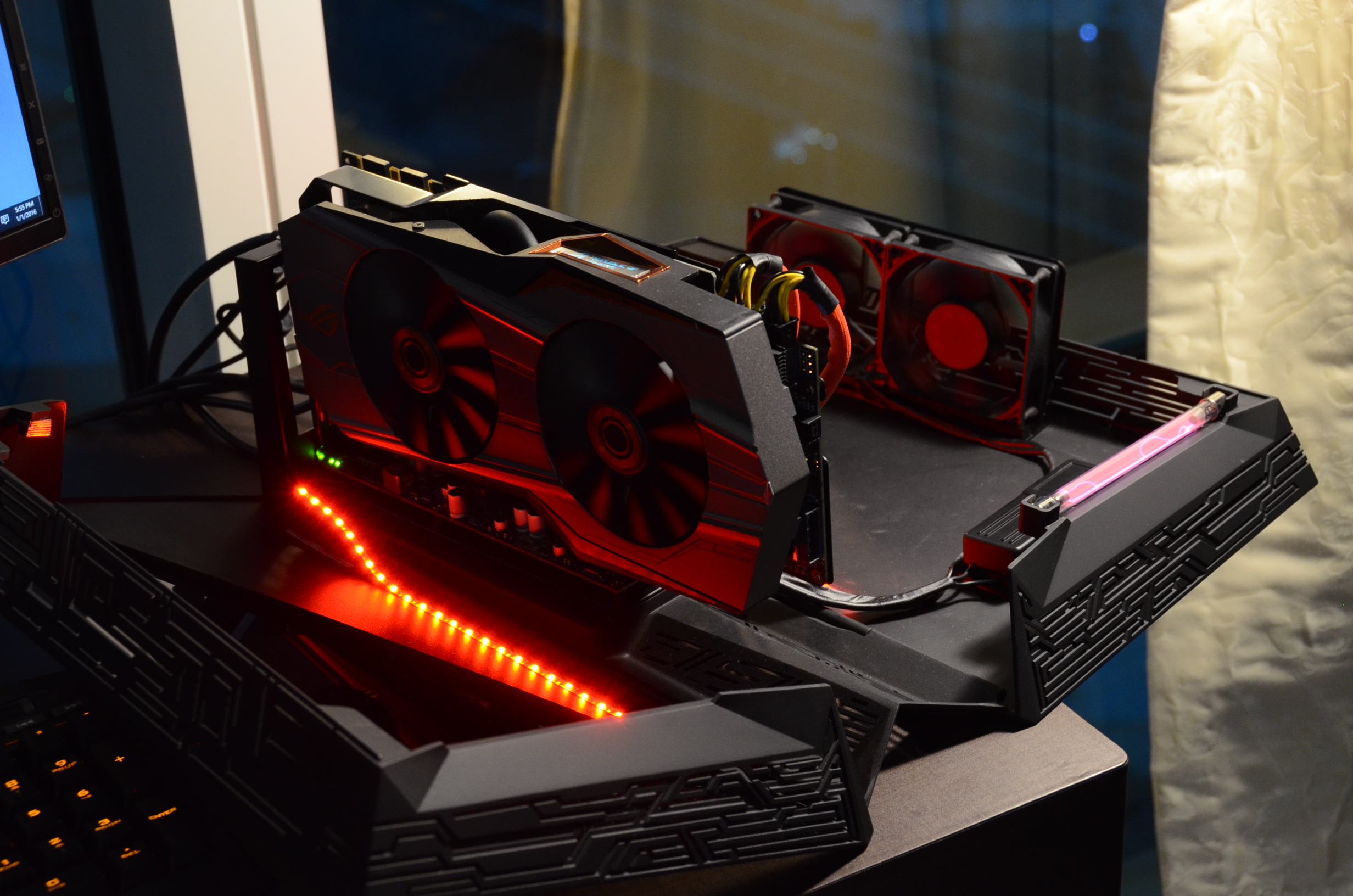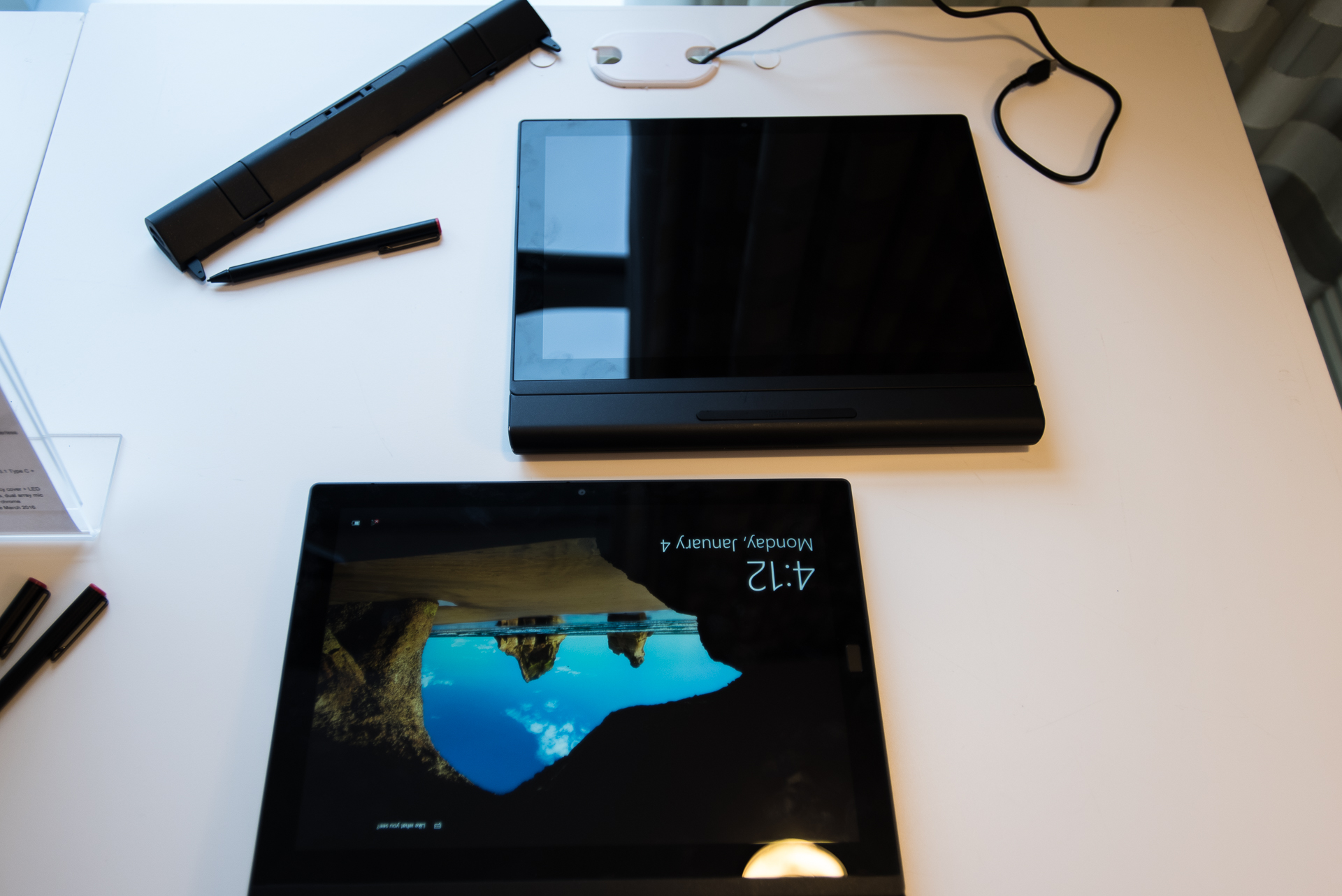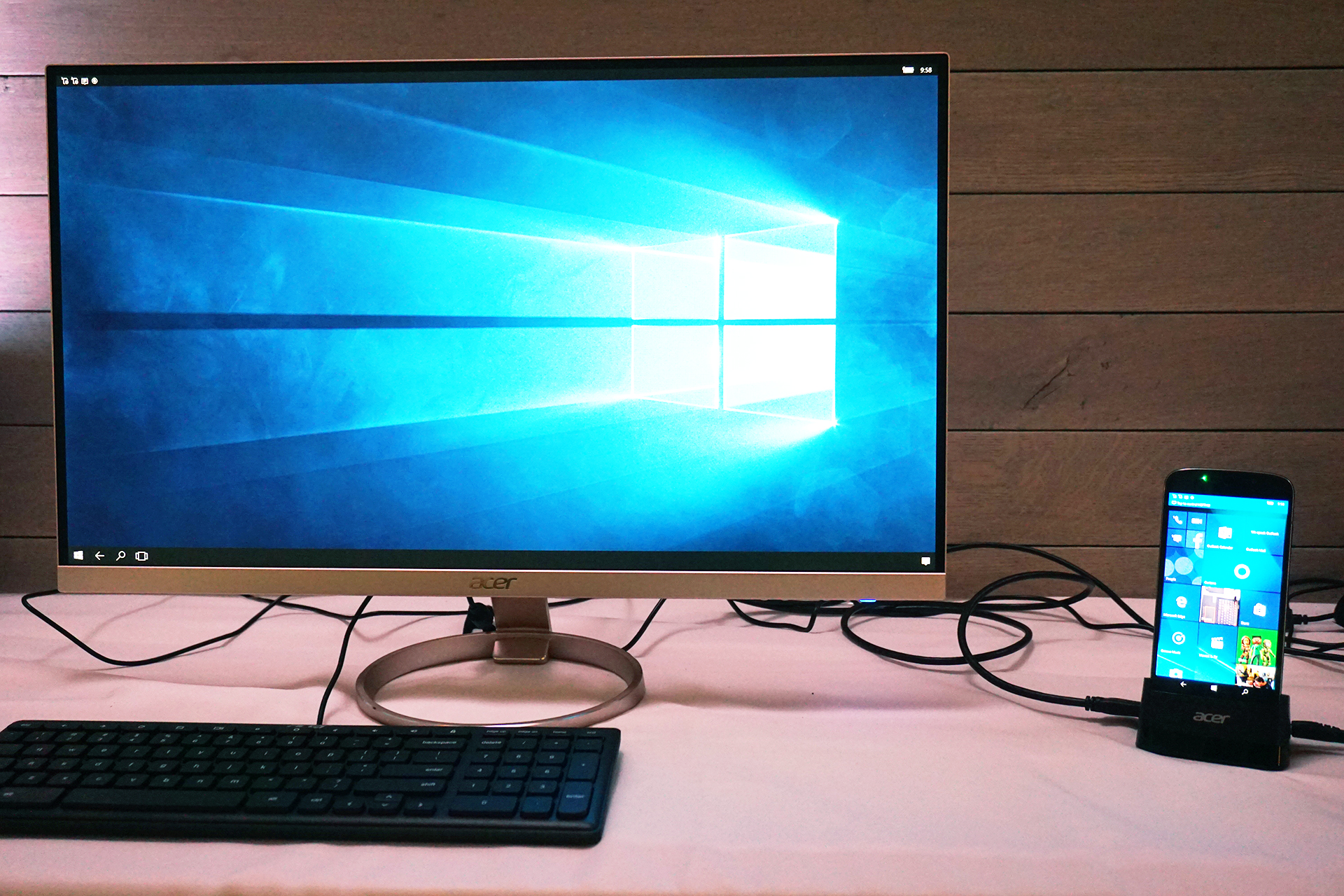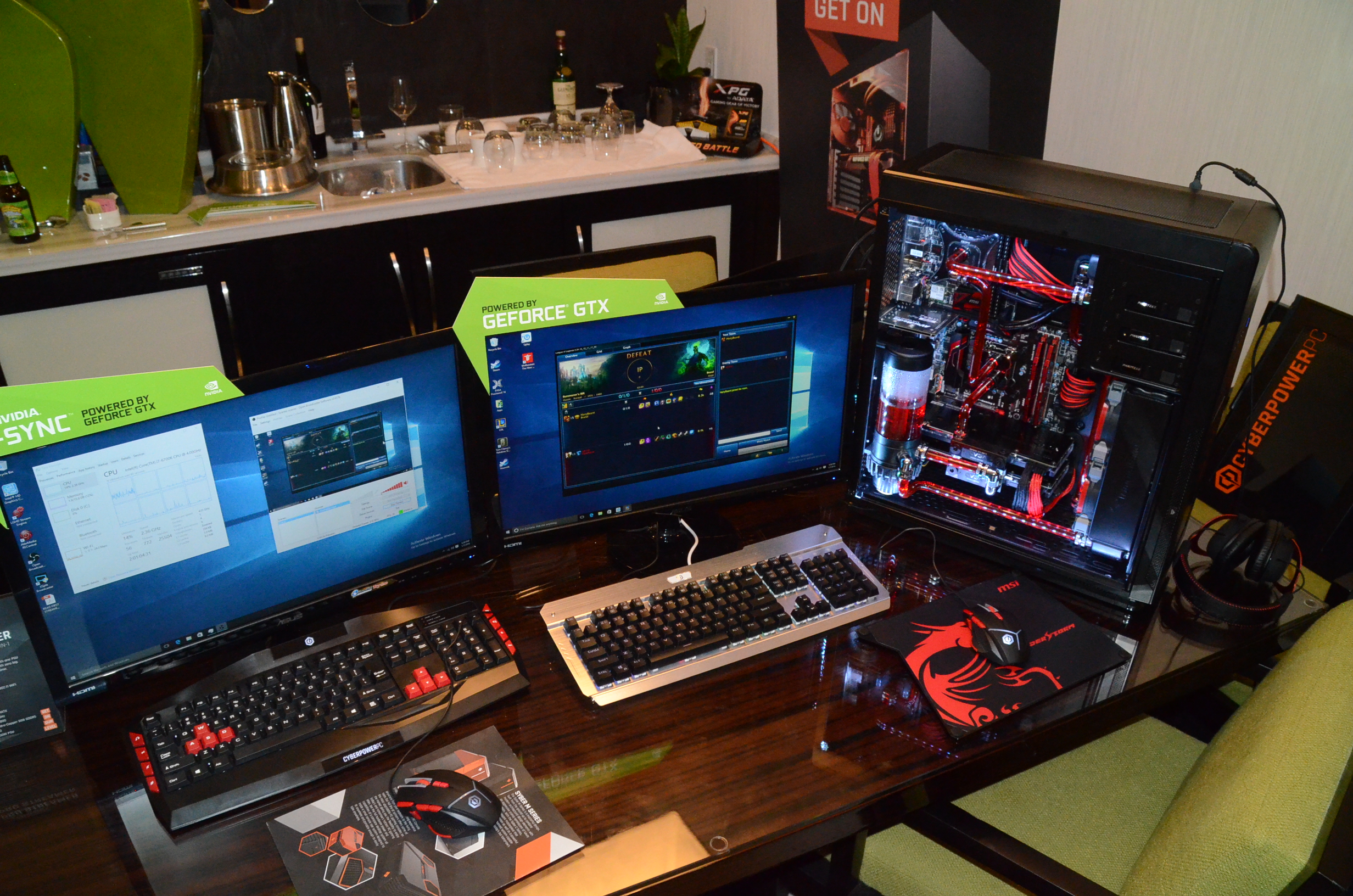An Unexpected CES Trend: Modularity
Every year at CES (and other large tradeshows such as Mobile World Congress and Computex), certain trends emerge. Increasingly at CES, those trends include throngs of quirky or gadgety tech such as smart-everythings (even faucets and beds) or Bluetooth speakers (so, so many Bluetooth speakers), but one that stuck out me this year was modularity.
Computing, In Pieces
The most obvious modular trend is coming in the form of external GPU docks. MSI and Alienware had external GPU docks last year, but the idea is catching on. Asus has one now, and so does Razer, and actually, MSI kind of has another one. We’re eager to test these out for ourselves in a comprehensive way, both practically (day-to-day) and with benchmarks, but the concept is attractive: You can have a svelte and light but powerful laptop to carry around for work or play, but when you need extra graphical horsepower, you can sit down at your desk and connect to a beefy GPU. As a side benefit, you can plug in all your desktop peripherals (including extra storage) to the GPU dock, which makes for a nice and tidy desktop setup.
Lenovo is taking a similar approach with its ThinkPad X1 Tablet. It’s a 2-in-1, which is a type of PC that is inherently modular because the keyboard can be detached, but Lenovo took that concept a leap further. In addition to an optional stylus, the company developed three modules that bring specific extra capabilities such as a projector or an Intel RealSense camera. Lenovo didn’t say that it was making more modules, but we imagine that it will, as requests from its customers start rolling in.
Both Asus and Gigabyte showed off gaming keyboards that have removable numpad/macro key pads that you can place on the left of the main keyboard for an extra bank of macro keys (or on the right for, uhh, accounting?).
Thought of a certain way, smartphone docks like the still-in-development model for the Acer Liquid Jade Primo and the Microsoft Display Dock for the new flagship Lumia phones are modular. The docks give you flexibility and also create more value and use cases for smartphones. You don’t need the docks, but they’re available if you want them.
You could even think of the burgeoning VR market as an inherently modular one. Even if you buy one of the marquee HMDs like the Oculus Rift or the HTC Vive Pre, those devices are technically peripherals. You still need a PC and hand controllers (although those should be included with the HMDs when they come to market), and there are more and more exciting add-ons coming, such as the 3DRudder and the Virtuix Omni treadmill. (In the case of the latter, you still need another controller like the rifle we used in our demo, to get the full effect).
You don’t need a VR treadmill or a foot controller or a rifle controller to get the full effect of VR -- necessarily -- but some people will want those things for some of their VR experiences. Peripherals for your peripherals.
Get Tom's Hardware's best news and in-depth reviews, straight to your inbox.
An Era Of Shifting Needs
Where is this modularity trend coming from? I believe that partly, we’re seeing some of this as a way for companies to overcome the commoditization of too many products, but also, as we’ve seen from the shifting form factor trend, people’s computing needs are becoming more specific.
There’s a burdensome weight to the increasing sea of sameness. We see this in smartphones, gaming laptops, peripherals (increasingly), motherboards and even many lower-end VR HMDs -- these “Google Cardboard plus” devices that are proliferating.
We need fresh ideas. Look no further than the RGB trend. Sure, fancy lighting is cool (really cool), but we’ve seen things come to market that turn out to be a previously-existing product, but with lights. Meh.
Really, the market increasingly demands the flexibility that modularity provides. Someone that wants to game at the highest settings in 4K does not necessarily need the same PC as the guy who wants a killer rig for recording music and running complex audio software in real time. The daily game streamer needs something different than the video producer. And so on, and so on.
CyberpowerPC is taking a whack at the issue with its ProStreamer line, which is essentially two PCs with different dedicated purposes crammed into one chassis.
Thinking of mobile computing, one of the executives at Purch Media (Tom’s Hardware’s parent company) that we saw at CES noted that with a dock and a phone like Acer’s Liquid Jade Primo setup, he wouldn’t have needed to bring his laptop to Las Vegas at all. Contrast that with what I (and many other journalists covering these tradeshows) need: I could really use a secondary display for my laptop as I write, fact check, and edit photos and video. Asus showed us a portable display (basically a USB Type-C version of this) that would be an ideal add-on for my hotel room productivity setup.
Again, that’s modularity at its finest. I’d have a laptop, a second display, massive external storage for scratch disks, mouse, and so on. That exec, using a smartphone/dock, a wireless keyboard/touchpad and any TV or monitor, would have an eminently portable, lightweight productivity solution. Different needs, different solutions.
How far might this go? Perhaps we could see something happen in the motherboard market, which is an area in which companies are struggling to differentiate themselves. What if you could select not just your motherboard, but the components present on the motherboard? You could choose how many and what type of PCIe slots or storage connections, for example, or swap out standard heatsinks for slick aftermarket solutions. A motherboard maker could start with a standard board design and let users configure them extensively. (Just a thought, motherboard makers.)
20/20
In hindsight, I realize that this has been coming for a while. Project Ara and Puzzlephone have been harbingers of a modular smartphone for some time, and of course there are the aforementioned GPU docks from a year ago. The 2-in-1 trend was a big marker, too, and new markets like VR/AR are introducing new problems that multiple products are solving in multiple ways.
Keep an eye out in the coming months and years for further innovations in the way of modularity.
Seth Colaner is the News Director for Tom's Hardware. Follow him on Twitter @SethColaner. Follow us on Facebook, Google+, RSS, Twitter and YouTube.
Seth Colaner previously served as News Director at Tom's Hardware. He covered technology news, focusing on keyboards, virtual reality, and wearables.
-
doron Choice is fine, but the iPhone has proven that people will rather have a simple device that can do many things okay-ish.Reply
Of course I may be wrong, but this development looks more like a management fear of being left behind / too many captains will sink the ship kinda thing. -
gadgety How about the type of modularity more than one user has asked for, the ability to switch off PCI-e GPUs not in use on a desktop system?Reply
Sometimes I need to max out the number of GPUs for Octane rendering, at other times I may want to run multiple cards in SLI/Crossfire for gaming, and at other times I may only need one GPU for MadVR, or even only integrated as I'm just browsing the web. In addition to raising running cost having many GPU running in idle is total waste, non environmentally friendly. With four 980ti's it's 280 watts just sitting idle, each additional card adding 70 watts. Sure the next generation GPUs are going to be more energy efficient, but it's still a waste. I've seen arguments that it can't be done on the PCI-e standard. Well, change and evolve the standard then. -
c4s2k3 Reply17354546 said:Choice is fine, but the iPhone has proven that people will rather have a simple device that can do many things okay-ish.
Of course I may be wrong, but this development looks more like a management fear of being left behind / too many captains will sink the ship kinda thing.
I have to agree on both counts. At some point you reach a situation where reliability of the overall product is negatively impacted by the number of hardware interfaces required to be supremely 'modular'. It's like I was reading a while back about that 'modular' phone (I forget the name) that was delayed because the various pieces were not holding together through anything other than 'careful' handling. As if that was supposed to be a surprising outcome :-/
In the end, if you make a multi-purpose product that is not modular, performs its functions reasonably well, and you can deliver it economically enough, there is little incentive for most people to want a modular alternative. I remember many years ago I would not touch a combo printer/scanner with a ten foot pole. If either component broke (and back then, that was a distinct possibility), you were stuck with it or it was prohibitively expensive to replace. Today, I wouldn't think twice given the price and reliability.
I think much of the modular trend we are seeing is about doing it because it's 'cool' or 'because you can'. Aside from techies who get excited about modularity, I don't see it gaining broad appeal because I expect evolving technology to yield more economical products over time, which can be combined reliably. -
scolaner ReplyHow about the type of modularity more than one user has asked for, the ability to switch off PCI-e GPUs not in use on a desktop system?
Sometimes I need to max out the number of GPUs for Octane rendering, at other times I may want to run multiple cards in SLI/Crossfire for gaming, and at other times I may only need one GPU for MadVR, or even only integrated as I'm just browsing the web. In addition to raising running cost having many GPU running in idle is total waste, non environmentally friendly. With four 980ti's it's 280 watts just sitting idle, each additional card adding 70 watts. Sure the next generation GPUs are going to be more energy efficient, but it's still a waste. I've seen arguments that it can't be done on the PCI-e standard. Well, change and evolve the standard then.
Yeah, good one. I think you're reinforcing my point, in a way a least: You have specific needs that aren't being addressed in the available tech. I think many enthusiasts have similar issues. (Mainstream users, too, for that matter.) -
codyleemanofaction I think the iPhone gives an example of modularity as opposed to the one-size-fits all that you stated: docking stations for music, cases with battery, camera lenses for macro, not to mention apps for individual needs.Reply
Now look forward to a day when your smartphone docks to a GPU and monitor via type-C... -
surphninja Another source may be that the tech has only now advanced to the point where some of these modular solutions were viable and practical.Reply -
Solandri Reply
In terms of smartphones, the point of modularity isn't really about pick-and-choose features. It's about upgrading at a lower cost. When you upgrade phones, most of the time the only thing that really needed upgrading was the CPU and RAM. Screen resolutions have pretty much maxed out, camera capability is "good enough" that anyone wanting better buys a DSLR, there are plenty of bluetooth speakers on the market, and GPU isn't exactly a make or break item.17354546 said:Choice is fine, but the iPhone has proven that people will rather have a simple device that can do many things okay-ish.
Most people upgrade phones because the CPU has gotten too slow or the RAM is insufficient for modern software. Make it modular and you can upgrade just those components for under $100, instead of $500-$700 for a new phone. (Ok, another major reason to upgrade is because you dropped the phone and broke the screen. But if that's modular too, you can simply replace it.)
The main impediment to modular phones (at least in the U.S.) is the current phone purchase model, where the carrier subsidizes it and hides its cost in your monthly bill. This has led to a massive market distortion where you pay $200 up-front for the high-end phone, pay nothing up-front for the low-end phone, both have the same monthly service charge. So the high-end phone ends up only costing $200 more than the low-end phone, instead of the $500 or so true difference in price. Effectively, the high-end phone is subsidized by the low-end phone. That leaves very little cost savings for a modular approach. This is gradually changing with T-Mobile leading the push to make the phone a separate purchase, so who knows where it'll lead.
Modularity adds bulk, but as components keep shrinking that additional bulk becomes less of an issue. In the general market, modularity wins out all the time over one size fits all. You can put different components into your PC. You can mount different brand tires onto your car. You can plug different headphones into your MP3 player. etc. -
Evodriver Your iPhone has to be one of the most annoying examples of rigid conformity and utter lack of modularity. Every iPhone user has the same interface all day, every day. It is connected to its own system of platform-specific accessories with a proprietary adapter yet again.Reply
This article is about modularity; the ability to change and interconnect devices. The iPhone is not modular. It doesn't even apply in the context of this article. -
doron ReplyYour iPhone has to be one of the most annoying examples of rigid conformity and utter lack of modularity. Every iPhone user has the same interface all day, every day. It is connected to its own system of platform-specific accessories with a proprietary adapter yet again.
This article is about modularity; the ability to change and interconnect devices. The iPhone is not modular. It doesn't even apply in the context of this article.
I don't see the problem. The iPhone has a very close OS and ecosystem, which stands in stark contrast to the products mentioned in this article, so it was brought up to reinforce my statement about modular vs non modular products in this segment.




